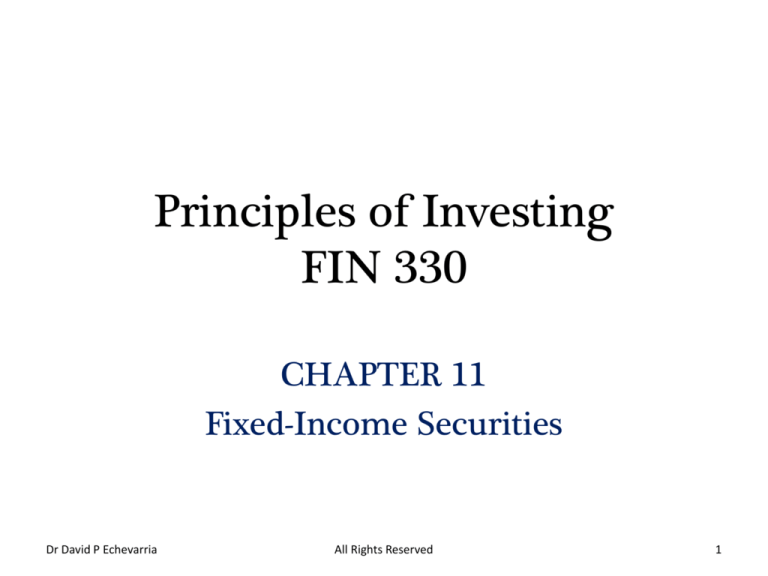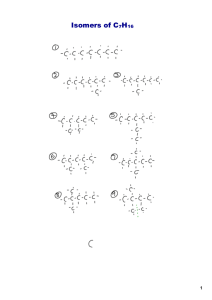
Principles of Investing
FIN 330
CHAPTER 11
Fixed-Income Securities
Dr David P Echevarria
All Rights Reserved
1
Student Learning Objectives
A.
B.
C.
D.
E.
F.
G.
Characteristics of Debt Instruments
Types of Debt Instruments
Bond Market Operation
Bond Ratings
Global Debt Securities
Managing Bond Portfolios
Review of Yield Curves & Forward Rates
Dr David P Echevarria
All Rights Reserved
2
Characteristics of Debt Instruments
A. Indenture Agreement,
1.
2.
3.
4.
B.
5.
Loan contract between lender and company
Appoints the trustee; a fiduciary responsible for guarding the
lenders' interests.
Terms and conditions, legal remedies
Sets the coupon rate (interest) and interest (coupons) payment
schedules
Maturity date of the issue
Special Repayment Provisions
1.
2.
3.
4.
Serial Redemption
Sinking Funds
Call provision: early retirement of bonds (with premiums to be
paid)
Put provision: permits bond buyer to sell bond back at face
value.
Dr David P Echevarria
All Rights Reserved
3
Types of Debt Instruments
A. Secured Debt: collateralized with real
assets [mortgage bonds, equipment trust
certificates]
B. Unsecured Debt: backed by full faith and
credit of the issuer [debentures]
C. Income (Revenue) Bonds: interest paid
only in issuer makes $$$
Bills/Notes/Bonds frequently called Fixed
Income Securities
Dr David P Echevarria
All Rights Reserved
4
Bond Market Operation
A. Most bonds sell in the OTC market
B. Government bonds by far the largest dollar volume:
Bills, Notes, Bonds, Agency bonds
C. Municipal bonds: issued by states, counties, cities
[general or revenue bonds] interest not taxable by
Federal Government
D. Corporate Bonds: typically better rates than
government/municipal bonds.
E. Short-Term Securities:
1.
2.
T-Bills, Commercial paper, Bankers’ Acceptances,
Negotiable CDs
S-T securities are mostly held in money market funds
Dr David P Echevarria
All Rights Reserved
5
Bond Ratings
A. Credit Worthiness key to interest rates paid,
probability of default
1.
2.
3.
High Quality/Investment Grade: AAA / AA, A, BBB
Speculative (“Junk”): BB, B
Default: [CCC, CC, C,] D
1.
Standard & Poor’s: Mainly corporate (industrials) and
sovereign debt
Moody’s: Banking, Insurance, Corporates
Fitch’s: Full range of coverage including international
issuers
Dun & Bradstreet: small to medium sized companies (213
million world-wide)
B. Rating Agencies
2.
3.
4.
Dr David P Echevarria
All Rights Reserved
6
Impact of bond volatility on
investors
A. Bond volatility affects potential for profits
from anticipated changes
B. Active bond portfolio management more
important in light of volatility - especially
since volatility increases potential for
losses.
C. Volatility makes it difficult to predict the
annual rate of return making strategies to
minimize interest rate risk more
important
Managing Bond Portfolios
A. Actively managed bond portfolios require
the investor to estimate:
1. interest rate trends (rising, falling)
2. interest rate volatility
B. Interest Rate Expectations Strategies
1. As interest rate rise, bond prices fall
a. short maturities are preferred.
2. As interest rate fall, bond prices rise
a. long maturities are preferred.
Managing Bond Portfolios
A. Bond portfolio composition depends on the
relationship between yield and maturity
1. term structure of interest rates
B. Adjustments to the average duration of a
bond portfolio alters the portfolio’s sensitivity
to changes in interest rates.
C. Volatility in bond portfolio values may also
be lowered by immunization and hedging
strategies.
Shape of the yield curve
A. Upward sloping yield curve (classic)
indicates short-term rates are lower than
long-term rates.
B. Changes in the yield curve and its shape
reflect changes in relationship of rates
and term to maturity.
1. Normal
2. Flat
3. Inverted
Normal Yield Curve:
Maturity versus Yield
7 .0 0 %
6 .5 0 %
Yie ld
6 .0 0 %
5 .5 0 %
5 .0 0 %
4 .5 0 %
4 .0 0 %
0
5
10
15
20
M a t u r it y ( y e a r s )
25
30
35
Current Yield Curve
(Bloomberg.com)
Nov 14, 2000
Implied Forward Rates
A. The Spot Rates are today’s prevailing rates.
B. The Forward Rate is the expected rate at some
point in the future
C. If forward rates are implied in the current spot
rates, then knowing the spot rates allows
calculating the forward rates.
D. Knowing the spot one year rate and the spot
two year rate allows calculation of the
expected one year forward rate a year from
now.
Implied Forward Rates
A. Finding implied forward rate t r n:
1. The rate for a loan made at the end of
time t maturing at time n.
(1 R n )
t rn
t
(1
R
)
t
n
1
n t
1
Locking in Forward Rates
A. Computing forward rates from spot rates
implies that investors can lock in future
rates of return.
B. To lock in a rate one year in the future:
1. Sell short the one-year bond today.
2. Purchase a multiple of a longer comparable
risk bonds today.
3. The net cash outlay must be zero.
Global Debt Markets
A. Dollar Denominated: Yankee or
Eurodollar
B. Foreign-Pay: denominated and paid in
foreign currency
HOMEWORK
A. Questions: 2, 3, 11, 12, 15
B. Problems: 1, 6
Dr David P Echevarria
All Rights Reserved
16









